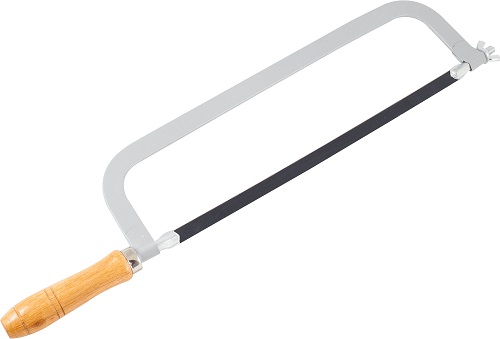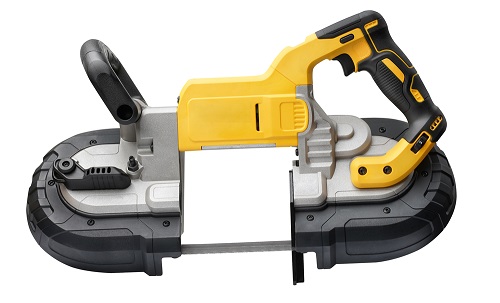Do you need to cut or chop something like metal and look forward to using a Power Hacksaw or Band Saw? They differ in how they perform/function and in many other factors. However, this detailed differentiation below will help you determine which will work best for your needs.
We will talk about how they differ in cost, working speed, efficiency, time consumption, and more.
Outline
TogglePower Hacksaw

If you have heard about or understand how a non-powered or manual one works, you will find Power Hacksaw a lot superior or the enhanced version of it. It comprises 5 key components, which are:
- Vise/clamping tool
- Coolant unit/base
- The frame (here to put blade).
- Lever and crank disc
- Electric motor
When working with as big as 10/15mm of cutting diameter, you must put a Power Hacksaw to use. They will not just save you time/energy but also work efficiently as compared to manual ones.
How Does a Power Hacksaw Work?
- Once you decide on the metal piece you must chop off, the vice will help you hold it for the same. Also, for your understanding, the vice is connected to the base. Then there is the handle, by turning, which will help you loosen or tighten the vice. Once held, the vice will ensure it stays in place and does not move while chopping off.
- It basically starts chopping off a metal piece by first moving the arm forward, a little up, and going over the metal. Then, it moves backward and a little down to chop.
- It repeats the same procedure continuously until the metal is cut per your requirements.
Now, when the blade is chopping off the metal, both the blade and metal will get heated up instantly. At this point, you will have to use some coolant. It will have to be put on the blade.
What this will do is that it will help in cooling the blade, and furthermore, it will act as a lubricant as well for a smooth cutting operation. Another reason why the coolant is crucial is that it will save the blade from breaking after it gets heated up to a great extent.
Band Saw

It involves a process of cutting a material that happens at a constant speed and continuously. Its blade is very sharp and hence, provides you with the precise and uniform cutting of the material you wish to chop off. Regarding the types, it has 2, i.e., vertical to chop off materials like aluminum, and horizontal.
How Does a Band Saw Work?
Depending upon if you have to opt for curve cutting or straight line cutting, you can follow the process given below:
How to Cut Straight Lines Using the Band Saw?
- Opt for setting the blade guard over the stock, i.e., around ½ inch, and it has to be done before opting for material cutting.
- Before you opt for blade changing, you must verify that you are cutting it equidistant from the fence.
- Now, at this point, you need material to cut that could be 24 inches in length. It should have a line so it can be cut through.
- Make sure the material piece is aligned properly and equidistant from the blade. This way, you will not have to worry about making moderations or adjusting anything while cutting.
- Once done with the cutting process, turn the band saw off.
- On seeing the blade stop, marking the table has to be the next step using the pencil. Do so along the material’s edge.
- Now, opt to release the bolts with which the fence is getting held. After that, opt for setting the fence to the same line.
- Once done, opt for the retightening of the bolts.
How to Cut Curves Using the Band Saw?
- Opt for drawing the curve you wish to cut using a band saw with the help of a pencil.
- If you have to cut a curve with tighter spots, utilize a narrower blade and vice versa.
- You can also make relief cuts to easily chop off the excessive material.
- If you feel like the chopping off isn’t going as smoothly or uniformly as you want, opt for stopping and ensure adjusting the material before proceeding.
Differences Between the Power Hacksaw and Bandsaw
Despite certain similarities, there are several significant distinctions between the two cutting tools i.e. the power hacksaw and the band saw. By being aware of these variations, one may choose the tool that will produce the most remarkable results. Let’s explore them in detail:
1. Efficiency
Because of their faster cutting speeds, band saws typically outperform power hacksaws in terms of efficiency. Band saws have a maximum cutting speed of 200 feet per minute, but power hacksaws usually operate at speeds of about 100 feet per minute. As a result, band saws are more efficient overall since cutting jobs may be completed faster.
Band saws may be quicker than power hacksaws, but power hacksaws often do heavy-duty cutting tasks more effectively. This is because power hacksaws are made to handle thicker, more rigid materials that could be too difficult for band saws to cut through. Power hacksaws also have a deeper cutting depth than band saws, which makes it possible to cut thicker materials more effectively.
2. Cost
A band saw often costs more to buy outright than a power hacksaw. This is because band saws are more complicated devices that need more parts and precise production techniques. Because they’re of more outstanding caliber and last longer than overpowering hacksaw blades, band saw blades also tend to be more expensive.
Yet, because of their lower ongoing upkeep and replacement expenses, band saws are frequently more cost-effective in the long run, regardless of their higher initial cost. Power hacksaws could cost less upfront than band saws, but over time, their higher maintenance and replacement expenses may prevent them from being as cost-effective.
Power hacksaw blades are more likely to break and must be replaced more frequently since they are thicker and less flexible, unlike band saw blades. Furthermore, because of their more straightforward layout, power hacksaws frequently need more repairs and upkeep than band saws, which could lead to higher labor and repair costs.
3. Cutting Time
Cutting time is one of the main differences between the power hacksaw and band saw. Band saws are noted for their rapid cutting rates, which can lead to shorter cutting times and higher production. Because band saw blades are slim and adaptable, you can cut substances more effectively, resulting in fewer waste products and quicker cutting times.
As a result, you can complete such operations requiring higher cutting volumes and faster cutting speeds using band saws. On the other hand, Power hacksaws often cut slower than bandsaws, leading to longer cutting times. This slower cutting rate may prove advantageous for tasks that demand higher precision or slower cutting speeds, but it might be a disadvantage when speed is essential.
4. Tool Size
The bigger size of Power hacksaws may render them more stable while in operation, which can be helpful in some situations. However, compared to power hacksaws, band saws are typically more compact and portable, making them simpler to propel and set up in confined spaces.
This may be advantageous when there is a lack of available space, or the cutting tool must be moved often. Band saws can be less steady in operation due to their smaller size, which could be a drawback in some applications requiring higher precision.
5. Cutting Capability
The cutting capacity of the power hacksaw and band saw is one of their main distinctions. Band saws often cannot cut thicker or larger materials than power hacksaws can, and this is because power hacksaws’ more robust, thicker blades can withstand more demanding cutting operations.
Power hacksaws are appropriate for uses that call for deep cuts because they are bigger and permit a deeper cutting depth. On the other hand, band saws work better with thinner and more compact materials. Band saws’ thinner, more flexible blades enable more accurate cutting on smaller components with less material waste.
Band saws are also better suited to cutting thinner materials than power hacksaws since they typically possess a smaller cutting depth. Although they operate slower than power hacksaws, specialized band saws can still cut thicker materials.
6. Blade Life
Another significant distinction between these two cutting tools is the blade longevity of power hacksaws and band saws. The band saw blades can be less resilient compared to power hacksaw blades because they are thinner and more flexible. Nevertheless, band saw blades are less inclined to break or get dull when employed on more delicate or thinner materials.
As a result, recurring expenditures may be reduced by an extended blade life and reduced blade replacements. Furthermore, band saws’ thin, flexible blades enable more precise cutting with less material waste, expanding the blade’s lifespan.
Power hacksaw blades are frequently thicker and more robust than band saw blades, which can increase their toughness and longevity. Nevertheless, power hacksaw blades can break down or become dull when employed on harder or thicker materials. This may lead to more costly ongoing maintenance and regular blade replacements.
7. Variable Speed
The ability to operate at various speeds is the final significant distinction between power hacksaws and band saws. Variable speed settings are standard in modern band saws, giving the user more flexibility over the cutting speed. This can be helpful when cutting various materials or performing delicate or complex cutting activities that call for a slower cutting speed.
On the other hand, power hacksaws frequently lack variable speed settings, and the set cutting speed can reduce the tool’s flexibility and adaptability. Power hacksaws might be appropriate for demanding heavy-duty cutting operations requiring a fixed cutting speed. Still, they might be better for more minor, more accurate cuts that require considerable speed control.
Which is Better, a Power Hacksaw or a Band Saw?
Which tool will work for you requires the above factors to differentiate and reach a decision. Although the difference that we talked about in detail, in the above section, helps you make your choice between the two, this table will further ensure that you choose wisely.
| Bandsaw | Hacksaw |
| Cutting capacity is higher | Cutting capacity is low |
| Cutting of a bundle is possible | Cannot do |
| Costlier | Lesser costly in comparison to Bandsaw |
| Blades for chip removal | No blades for chip removal |
| Can change speed | Speed is constant |
| Swing cutting is optional | Only allows swing cutting |
| Use of a blade that is circular | Use of blade that is square teeth and straight |
Conclusion
Although both power hacksaws and band saws have distinctive qualities and benefits, the decision will ultimately rely on the user’s tastes and specific cutting needs

